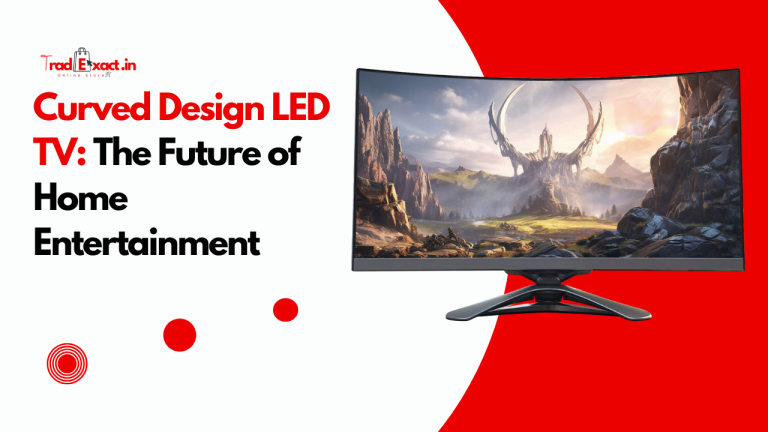
The evolution of television technology has significantly transformed how we experience home entertainment. From the bulky CRT screens of the past to the ultra-thin and high-definition OLED panels of today, the television industry has continually innovated to enhance picture quality, immersive viewing, and smart home integrations. One of the most striking advancements in TV design has been the Curved Design LED TV, a concept that promised an enhanced and more immersive viewing experience. While curved TVs have seen fluctuating popularity, they remain a topic of discussion in the industry. In this blog, we will explore the advantages of curved TVs, the challenges they face, and whether they hold a promising future in home entertainment.
What is OLED?
OLED (Organic Light-Emitting Diode) is a display technology that has revolutionized television screens by offering superior contrast, deep blacks, and vibrant colors compared to traditional LED TVs. Unlike LED TVs, which rely on backlights, OLED TVs consist of self-emitting pixels that can individually turn on and off. This results in better color accuracy, true black levels, and improved contrast ratios, making them an excellent choice for both home entertainment and professional applications. Additionally, OLED technology allows for ultra-thin and even flexible displays, making it possible to create innovative designs such as curved and rollable screens.
Why is OLED Better?
OLED technology provides several significant advantages over traditional LED and LCD screens. One of the primary benefits is deeper blacks and infinite contrast, as each pixel operates independently and can turn off completely, unlike LED TVs that rely on backlighting. Viewing angles are also significantly improved, as OLED screens maintain their color accuracy even when viewed from the sides, making them perfect for larger rooms where viewers may not always sit directly in front of the TV. Faster response time is another advantage, making OLED TVs ideal for gaming and fast-action content, as they reduce motion blur and lag. Furthermore, energy efficiency is another highlight, as OLED panels consume less power compared to backlit LED displays when showing darker images, making them a more sustainable option in the long run.
Continue reading about How to Choose the Right TV: A Complete Buying Guide with this link.
Problems with OLED
Despite its numerous advantages, OLED technology is not without its drawbacks. One of the most talked-about issues is burn-in, where static images can cause permanent screen retention over time. This is particularly problematic for users who frequently watch news channels, use their TVs as computer monitors, or play video games with static UI elements. Higher price is another concern, as OLED TVs are generally more expensive than traditional LED models, making them less accessible to budget-conscious consumers. Additionally, lifespan concerns exist, as blue OLED pixels tend to degrade faster than red and green pixels, potentially leading to color shifts and reduced picture quality over time.
Key Features of Curved UHD TV
Curved UHD TVs provide an immersive viewing experience by utilizing their unique screen design and advanced technology. One of their key selling points is the panoramic effect, which enhances the perception of depth, making images appear more lifelike and engaging. The wider field of view offered by curved screens makes it easier for viewers to focus on the entire screen, reducing eye strain. Some curved TVs also boast enhanced contrast due to the way they direct light towards the viewer’s position, creating an improved visual experience in the right setting. Additionally, curved screens can help reduce glare by minimizing reflections from ambient light sources, though this benefit depends on the placement of the TV and the surrounding environment.
Continue reading about How to Choose the Right TV Size for Your Room with this link.
Is a Curved LED TV Better Than a Flat TV?
Curved TVs come with their own set of advantages and disadvantages when compared to traditional flat-screen models. In terms of benefits, curved TVs provide a more immersive experience, especially for single viewers sitting at the optimal distance. The curved design can also add a modern aesthetic appeal to home theater setups. Another advantage is the slight improvement in depth perception, as the curved screen helps create a more natural sense of dimension in images. However, there are also notable drawbacks. Viewing angles can be an issue when watching from the sides, as the curvature of the screen can distort images for viewers who are not sitting directly in front of the TV. Additionally, curved TVs tend to be more expensive than their flat counterparts, and their limited availability means fewer choices for consumers.
Do Curved TVs Still Exist?
Yes, curved TVs are still available on the market, though they are far less common than they were a few years ago. Some manufacturers continue to produce curved TVs for niche markets, particularly for gaming and luxury home theater setups. However, as flat-screen TVs continue to dominate the industry due to their versatility, the production of curved TVs has significantly decreased.
Why Did They Discontinue Curved TVs?
Curved TVs initially gained popularity due to their promise of an enhanced immersive experience, but they never achieved widespread success. Several factors contributed to their decline, including limited viewing angles, which made them less practical for group viewing. Higher costs also played a role, as curved TVs were more expensive to manufacture and market. Additionally, many consumers preferred flat TVs for their ability to be easily wall-mounted and placed in various room setups.
Continue reading about Welcome to the Future of Shopping: Tradexact Goes Live on the B2C Market! with this link.
Is There a Curved OLED TV?
Yes, some brands, such as LG, have produced curved OLED TVs, combining the benefits of OLED technology with the immersive design of a curved screen. However, these models are rare and primarily cater to high-end users looking for unique home theater experiences.
Immersive Gaming Experience: Curved Design LED TV
Curved TVs and monitors are popular among gamers because they create a more engaging and immersive environment. The curved design wraps the screen around the player’s peripheral vision, enhancing depth perception and reducing distractions. This is particularly beneficial for fast-paced games, as it helps gamers stay focused on the action.
Smart Home Integration: Curved Design LED TV
Modern curved LED TVs come equipped with advanced smart features that allow seamless integration with smart home ecosystems. They support voice control via Alexa, Google Assistant, or Siri, enabling hands-free operation. Additionally, built-in streaming apps like Netflix, Amazon Prime, and YouTube offer effortless content access, making smart TVs the centerpiece of modern home entertainment setups.
Sustainability and Eco-Friendly Innovations
TV manufacturers are increasingly focusing on sustainability by incorporating energy-efficient LED backlights, recyclable materials, and reduced hazardous substances in production. These efforts contribute to reducing electronic waste and promoting environmentally responsible consumption.
Continue reading about The Benefits of Android TV vs. Google TV vs. WebOS with this link.
Better Streaming and Content Options
With the growing demand for high-quality content, curved LED TVs offer enhanced viewing experiences for 4K and 8K streaming. Features like HDMI 2.0 and USB 3.0 ports ensure seamless connectivity for external devices, making it easier for users to access high-definition content.
3D and Holographic Displays: Curved Design LED TV
While 3D TVs failed to gain mainstream success, advancements in holographic displays and augmented reality could redefine how we experience television content in the future.
Wireless and Invisible Technology
Upcoming innovations aim to eliminate cables and clutter, with features such as wireless HDMI and Bluetooth audio systems, allowing seamless connections without visible wires, enhancing aesthetics and convenience.
Continue reading about OLED or 4K UHD? with this link.
Future-Proofing Your Purchase
If you’re considering a new TV, it’s essential to future-proof your investment by choosing a model with advanced display technology, multiple connectivity options, and smart features that integrate with your home setup.
Why Lotus Electronics is Your Go-To Destination
Lotus Electronics offers a premium range of Curved Design LED TVs, ensuring top-notch quality and competitive prices. With excellent after-sales service and a vast selection, it’s a trusted destination for your next TV upgrade.
Conclusion: Curved Design LED TV
The future of home entertainment continues to evolve with advancements in TV technology. While curved LED TVs offer unique benefits, their appeal remains limited to specific audiences. Whether you choose an OLED, QLED, or traditional LED model, selecting a TV that aligns with your viewing habits and setup is key. Explore the latest innovations and make an informed decision for the best home entertainment experience.
Continue reading about Best Smart TV for 2025: Samsung, LG, Roku, and More with this link.


 Welcome to Tradexact – Where Deals Drop & Savings Soar!
Welcome to Tradexact – Where Deals Drop & Savings Soar! 
 Premium Brands |
Premium Brands |  Lowest Prices |
Lowest Prices |  Fast Delivery
Fast Delivery 